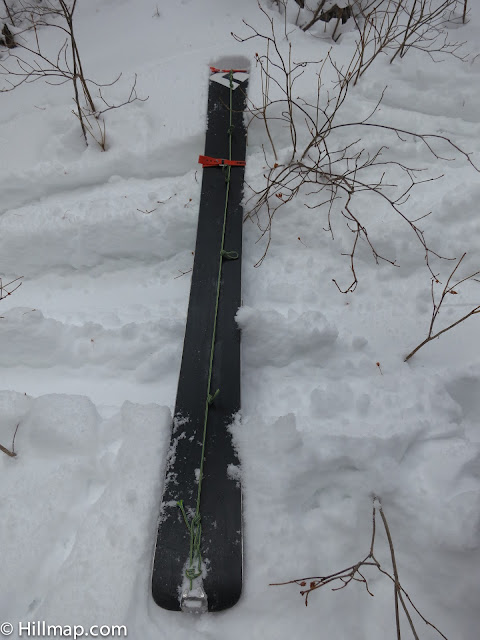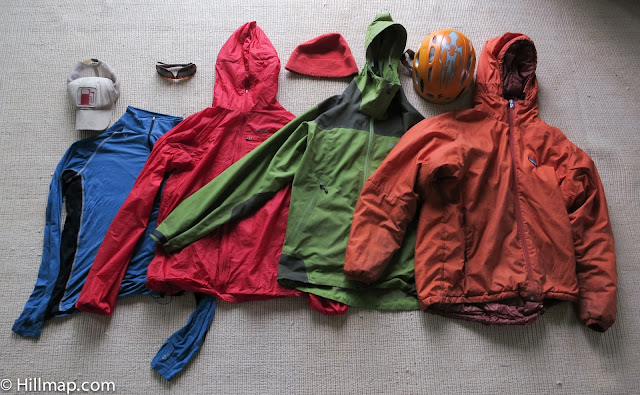For years I searched for the perfect glove. I get cold hands easily but I hoped to find one glove waterproof enough to handle snow, breathable enough to skin in and yet warm enough to ski down in. I had no luck and my pack swelled with spare pairs of high tech gloves.
Upon moving to the Northern Rockies I was forced to realize that such a glove does not exist. The only real option for an extended tour that starts in mild weather at a low elevation trailhead and ends at a storm blown summit thousand of feet above is a system of gloves: a few pairs of low bulk fleece liners, a shell and a warm mitten.
 |
| Jen wearing thin fleece gloves booting up a sunny trail on a cold spring morning. |
Liner Gloves
Liner gloves are the backbone of this system. They are worn by themselves while hiking or skinning and under a shell or puffy glove when more protection is needed. They don't weigh much and take up little space so I usually bringing 2-3 pairs for when one pair inevitably gets wet from sweat or snow. I generally bring 2 thin pairs and a thicker pair.They are available in different fabrics of varying thicknesses and warmths. Some of the notable fabrics include:
- Wool and Wool Blends - Though it doesn't dry as fast as fleece the texture of wool handles moisture well. The texture of the fibers keeps air against your skin making them feel drier than they are.
- Polartech Powerstretch - A thin very breethable fleece with a fuzzy inside and harder outside offering some weather protection. Several manufactures now have viable copies of this fabric as well.
- Polartech Windpro - Like powerstretch with an even tighter outer weave offering better weather protection but a little less breathability.
- Gore Windstopper - This fabric uses an actual membrane laminated into the fleece offering amazing wind resistance but greatly hurting breathability.
Some of our favorite glove liners in order of increasing warmth are:
- Ibex Knity Gritty - A light and relatively cheap wool liner glove that is great in humid warmer conditions.
- Outdoor Research PL 100 - One of my workhorse gloves. At the moment this glove works well skinning in conditions warmer then 20F or used with a shell below that. The "radiant" fabric is similar to Powerstretch.
- Outdoor Research Backstop - Similar to the PL 100 but with the back panel made from Windstopper to provides some protection without hurting the breathability too much. This seems like a really good idea but in practice I've found it difficult to tell the difference between these and the PL 100.
- Rab Phantom Grip Glove - Jen's workhorse and one of my favorites as well. These are made with Windpro fleece to add weather resistance while maintaining breathability. The "Phantom" grip pattern on these is also the best in the industry and is available on a lighter Powerstretch glove as well.
- Outdoor Research Windstopper Gripper - These are durable and weather resistant gloves made from Windstopper. My hands sweat too much to use them while skinning but I know people who can wear them happily all day.
- Outdoor Research Flurry Gloves - These are made with a wool nylon blend that breaths and handels moisture well over a poly liner. I don't have a pair but Jen has worn hers all day during a snow storm. The glove material is fleece on the inside and wool on the outside - this fabric is excellent at wicking moisture from the inside to the outside of the gloves.
- Outdoor Research PL 400 - A super warm but breathable glove made from two layers of fleece. We usually bring these to keep in reserve for use in the coldest part of the day or if we get stuck out longer then expected.
My Lightest, Most Versatile Glove System
- Uninsulated Outer Shell from Black Diamond Mercury Mitts. I generally uses these directly over my liners when I need a bit of extra warmth or protection from wind and wet.
- Insulated Liner from Black Diamond Mercury Mitts. I also generally use these by themselves to add warmth at stops, though I like to know that I could use them with the outers in extreme cold/nasty conditions like an unplanned night out in a storm.
- 2-3 pairs of liner gloves. Usually OR PL 100, Rab Phantom Grip and a pair of OR PL 400's buried in the pack somewhere.
 |
| Uninsulated mitten shells like the outer from the Mercury Mitt are perfect to add over liner gloves while skiing. |
 |
| Warm but light mittens like the Mercury liners are essential at rest stops on cold days. |
 |
| While skinning I can regulate temperature to prevent sweating out my liners by taking shells on and off placing them on my ski poles or inside my jacket. |
More Dexterity
I generally find that I can do most things I need to using either liner gloves or liner gloves under my mitt shells but there are times where I need a better combination of warmth and dexterity These include operating a camera in nasty weather, scrambling etc. For this reason I sometimes supplement or replace the Mercury Mitt shells with the shells from some Black Diamond Guide Gloves as shown above. I rarely use the guides with their included liner but it is difficult to find a plain uninsulated glove shell.
Other (Cheaper) Options that are Awesome
 |
The two gloves systems above have been used on most of my tours this winter but I also have some other less expensive gloves that I like and use for skiing close to the road, in area or in warmer conditions. These are especially great if you don't want to ruin your good gloves doing rough work like cutting wood for a fire or grabbing a rope tow. Some of the stand outs are:
- OR insulted mittens - I got these in the REI bargin basement and am not sure on the exact model. They aren't as warm as the Mercury Mitts but they are less bulky and I often throw them in warmer conditions instead of the Mercury Mitt liners when I bring the Guide shells.
- Kinco 901 Ski Gloves - This is a burly, cheap and warm full leather glove preferred by many ski lift operators and ski patrollers Waterproofed with Sno Seal it is my favorite glove for in area skiing or working outside on very cold days. I would bring them on backcountry ski trips, but they are a bit on the heavier side.
- Kinco Lined Work Gloves - A lighter soft shelled Kinco glove this glove is still too warm to skin in but great for skiing on sunny days and general winter wear.
- Buck Skin Gloves + Liner - In a gear list he posted on Backpackinglight.com Dave Chenault suggested using a plain buckskin work glove with a liner glove.
- Sno Seal - This stuff is basically beeswax and is essential for waterproofing leather. To apply you should warm up your gloves (in the oven, by the fire, or in direct sun) to open the pores in the leather. Then put the gloves on and apply the Sno Seal all over as if you were rubbing lotion into your hands and put them back in the warm place to let the Sno Seal soak in. One light coat may be sufficient for dry climates and won't ruin the breathability but for the wet Cascades 3-4 coats is better.
 |
| Skiing in Kinco Work Gloves at Lolo Pass. |













































